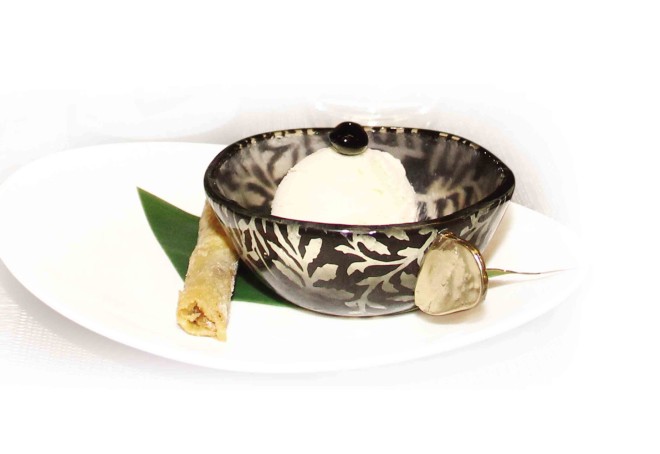
Yakumi restaurant at Solaire Resort and Casino held a sake tasting session recently. The six-course dinner featured Hakkaisan, a renowned sake brand brewed in Japan.
Yakumi’s subtle, modern interiors provided the ideal ambiance to taste the different blends of Hakkaisan sake.
Before dinner, guests listened to Solaire head sommelier Daniel Blais give a short talk on Hakkaisan.
Sake, Japan’s national beverage, is made from fermented rice. Unlike wine, in which the alcohol is produced by fermenting naturally occurring sugars in grapes, sake is produced in a process similar to that of brewing beer—the starch is first converted into sugar, then into alcohol.
Special rice
Hakkaisan Sake is brewed in the Niigata prefecture, the third largest manufacturer of sake in Japan. Niigata’s special Koshihikari rice is known as the finest in Japan.
The sake produced by Hakkaisan is pure and distinct in flavor because it sources water from the snow-capped mountains of Hakkai. “What makes sake of high quality is the water used, the rice and most especially how they process and polish the rice,” said Blais.
Yakumi served six dishes paired with six Hakkaisan variants.
“Many people ask me if we should drink sake hot or cold,” Blais said. “Any alcohol, be it cognac, whiskey, brand, when you warm it, will elaborate the aromas, meaning the distinct and subtle flavors are released. That’s the good news; the bad news is that in the next five minutes you will lose everything”
Any which way
Blais explained that when sake was first created, its quality was not as pure and good as it is now. The early sake brewers used to heat it up to elaborate the aromas, to compensate for its lack of quality in those times.
“Today, the quality of sake worldwide is exceptional, so you don’t need to heat up your sake,” Blais noted.
He recommended that we drink sake any which way: “If you prefer hot, take it hot. If you prefer warm, drink it warm. If you want it cold, do it cold. Take a large wine glass, pour sake, some soda, ice cubes and add slices of lemon—it’s beautiful and delicious when you drink it by the pool.”
Smooth, mild, intricate
The first course included assorted sashimi, sushi, and maki dish paired with a Hakkaisan Tokubetsu Junmai—very smooth taste and flavor, and paired well with the sashimi.
For the second course, marinated red snapper with chef Norimasa’s special sauce was paired with the Hakkaisan Honjozo, a light and easy drink with mild flavors of Japanese koji and rice.
The third course was a delectable grilled duck with sansho spices, paired with a Hakkaisan Ginjo, a fortified sake, its flavors more intricate and robust.
The rich drink was a good foil to the distinctly umami flavors of the dish.
The fourth course has grilled Chilean sea bass served with a Hakkaisan Daiginjo, which had a crisp and clear flavor. It was said to be the top tier in Hakkaisan’s line of sakes.
Daiginjo uses the special Yamadanishiki rice, which is polished until only 40 percent of the rice grain remained.
It had a very clean and smooth character, perfect with the miso sauce used in the Chilean sea bass.
Refreshing acidity
The fifth dish was a duo of beef sukiyaki and beef tenderloin in garlic roll, served with Hakkaisan Sparkling Nigori—which had a refreshing acidity that countered well the strong flavors of the beef dish.
Last to be served was the sake kasu ice cream and fried sweet red beans spring rolls, a standout dish in the entire dinner.
The sake ice cream beautifully captured the many subtle flavors of sake.
The dish was made by first boiling sake until the alcohol evaporated and all that was left was the sake flavor. The liquid was then used to make the ice cream.
The fried red bean spring roll went well with the Hakkaisan Junmai Ginjo.
Taken with the ice cream, the Junmai Ginjo intensified the dessert’s sake flavor.
With lots of sake bottles still half-finished, we all shouted, “Kampai!”
Yakumi is at Solaire Resort and Casino, 1 Solaire Blvd., Manila Bay Reclamation Area, Pasay City; tel. 8888888. Hakkaisan sake varieties are available at Yakumi.